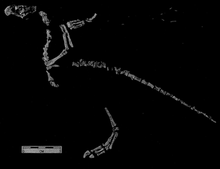| Protoavis Temporal range: Late Triassic,
| |
|---|---|

| |
| Protoavis texensis paratype (TTU P 9201) | |
| Scientific classification | |
| Domain: | Eukaryota |
| Kingdom: | Animalia |
| Phylum: | Chordata |
| Class: | Reptilia |
| Clade: | Neodiapsida |
| Clade: | incertae sedis |
| Genus: | †Protoavis |
| Type species | |
| †Protoavis texensis Chatterjee, 1991
| |
Protoavis (meaning "first bird") is a problematic taxon known from fragmentary remains from Late Triassic Norian stage deposits near Post, Texas. The animal's true classification has been the subject of much controversy, and there are many different interpretations of what the taxon actually is. When it was first described, the fossils were described as being from a primitive bird which, if the identification is valid, would push back avian origins some 60–75 million years.
The original describer of Protoavis texensis, Sankar Chatterjee of Texas Tech University, interpreted the type specimen to have come from a single animal, specifically a 35 cm tall bird that lived in what is now Texas, USA, around 210 million years ago. Though it existed far earlier than Archaeopteryx, its skeletal structure is more bird-like. Protoavis has been reconstructed as a carnivorous bird that had teeth on the tip of its jaws and eyes located at the front of the skull, suggesting a nocturnal or crepuscular lifestyle. Reconstructions usually depict it with feathers, as Chatterjee originally interpreted structures on the arm to be quill knobs, the attachment point for flight feathers found in some modern birds and non-avian dinosaurs. However, re-evaluation of the fossil material by subsequent authors such as Lawrence Witmer have been inconclusive regarding whether or not these structures are actual quill knobs.
However, this description of Protoavis assumes that Protoavis has been correctly interpreted as a bird. Many palaeontologists doubt that Protoavis is a bird, or that all remains assigned to it even come from a single species, because of the circumstances of its discovery and unconvincing avian synapomorphies in its fragmentary material. When they were found at the Tecovas and Bull Canyon Formations in the Texas panhandle in 1973, in a sedimentary strata of a Triassic river delta, the fossils were a jumbled cache of disarticulated bones that may reflect an incident of mass mortality following a flash flood.